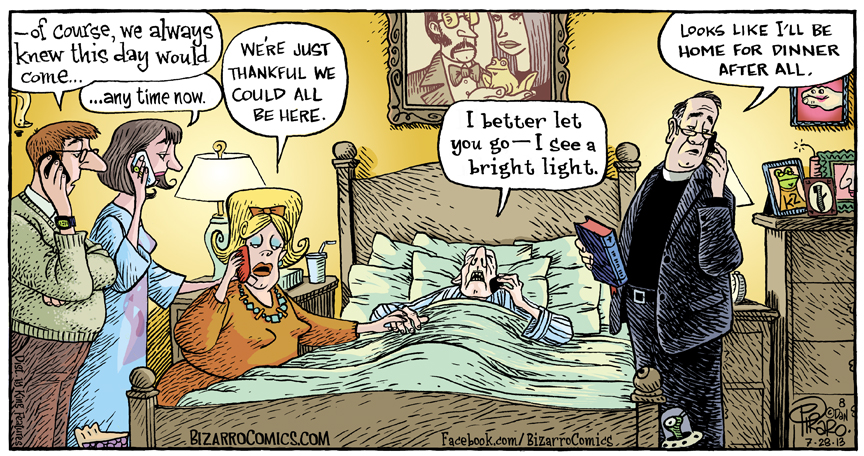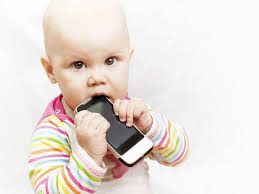 Last Words, Sunday’s Bizarro by Dan Piraro is a hilarious cartoon on how our culture is so obsessed with cell phones. He writes, “I have not one shred of doubt that this scene, or something quite like it, is playing out all over the world at this very moment.”
Last Words, Sunday’s Bizarro by Dan Piraro is a hilarious cartoon on how our culture is so obsessed with cell phones. He writes, “I have not one shred of doubt that this scene, or something quite like it, is playing out all over the world at this very moment.”
Category: cell phones
Is Wi-Fi safe?
This is an excellent introduction to wi-fi radiation in schools, the science, government response, and how the radiation compares to ambient background and cell tower levels.
“Convenience is not an acceptable reason to risk the health and safety of children.” Learn more about wi-fi in schools: WiFi in Schools.com Learn more about the science: BioInitiative.org
Chemicals in electronics can harm kids
 University of Cincinnati College of Medicine researchers presented a new study that shows that flame retardants used in everyday products including electronic devices is associated with hyperactivity and lower intelligence in early childhood.
University of Cincinnati College of Medicine researchers presented a new study that shows that flame retardants used in everyday products including electronic devices is associated with hyperactivity and lower intelligence in early childhood.
At issue are substances called polybrominated diphenyl ethers, or PBDEs. They’ve been widely used as flame retardants.
Aimin Chen, MD, PhD, an assistant professor of environmental health, was the lead author of a study presented recently at the Pediatric Academic Societies (PAS) annual meeting in Washington, D.C.
“PBDEs are everywhere,” Chen says of the chemicals used in such products as baby strollers, carpeting and electronics. “In the United States, almost everyone has detectable levels of PBDEs in their serum.”
While some manufacturers have voluntarily phased out PBDEs in the past decade and additional phase-outs are scheduled this year and beyond, Chen says, the problem won’t simply go away.
“These chemicals stay in the environment for long periods of time” he adds. “They get into the food chain, and babies get exposure from their mothers during pregnancy. Breast milk also contains PBDEs.
“In animal studies, PBDEs can disrupt thyroid hormone and cause hyperactivity and learning problems,” says Chen. “Our study adds to several other human studies to highlight the need to reduce exposure to PBDEs in pregnant women.”
Chen and his colleagues at UC collected blood samples from 309 pregnant women enrolled in a study at Cincinnati Children’s Hospital Medical Center to measure PBDE levels. They also performed intelligence and behavior tests on the women’s children annually until they were 5 years old.
“For all these technologies we’re actually further apart, you know what I’m saying… Hello?
“Excuse me sir could you please put your phone down. You’re not walkin’ straight, your stumblin’ around. You’re in public man, you’re being kind of rude. Your text messages are not that important dude!”
“Excuse me lady, could you put your phone down. Your talking too loud like nobody’s around. I’m sure your friend can wait to hear what you have to say. I don’t want to know that much about your day…”
From the creators of “Whole Foods Parking Lot” and “Yoga Girl”. DJ Dave “goes dumb” on smart phones in this public service announcement to those among us who are emotionally, physically or surgically tied to our “pieces”. In today’s world of technology driven hyper-communication, its good to exercise your interpersonal skills, lest they atrophy. Here’s Put Your Phone Down:
Professor Olle Johansson Warns of Wireless DNA Damage
Resonance: Beings of Frequency (documentary film)
Secondhand radiation can be considerable according to a newly published study.
By: Joel M. Moskowitz, Ph.D. Director, Center for Family and Community Health, School of Public Health, University of California, Berkeley
Many people are unaware that they are exposed to cell phone radiation when their cell phones are in standby mode. This occurs because their cell phone contacts the nearest cell tower periodically to update its location.
In a moving vehicle, cell phones in standby mode contact cell towers more frequently. Thus, exposure to cell phone radiation from one’s cell phone is greater in transit.
Two Swiss researchers, Damiano Urbinello and Martin Roosli, set out to measure personal cell phone radiation exposure during car, bus and train trips when one’s own phone was in standby mode.
Their study just published in the Journal of Exposure Science and Environmental Epidemiology identified a source of cell phone radiation that may constitute a public health problem. Namely, secondhand exposure to cell phone radiation from other people’s cell phones can be considerable while traveling on buses and trains (1).
During bus or train trips, individuals may be exposed to considerable amounts of cell phone radiation from other people’s cell phones. Buses and railroad cars act like “Faraday cages” that reflect much of the electromagnetic radiation emitted by cell phones throughout the vehicles’ interiors. Thus, all passengers, including infants and pregnant women as well as those without cell phones, may be exposed to considerable levels of cell phone radiation emitted by others’ phones.
As for car trips, the results of the study suggest that exposure to cell phone radiation from one’s own phone in standby mode is relatively low compared to overall exposures during public transit. Nonetheless, those who are concerned about their exposure to cell phone radiation should turn off their phones during car trips, or at the very least, avoid using their phones for calls.
● “The study indicates that own uplink exposure during car driving can be considerably reduced (about a fraction of 100) when turning off ones own mobile phone in order to prevent it from location updates.” (1)
The researchers found that GSM, the 2G carrier system in Europe which is used in the U.S. for voice communication by AT&T and T-Mobile, is particularly problematic compared to UMTS, a 3G carrier system used for data transmission. The researchers did not test CDMA which in the U.S. is used by Verizon and Sprint for voice calls. Other research has found that GSM emits 13 to 28 times more radiation on average than CDMA during phone calls. No published studies have examined exposures from LTE, the 4G carrier system now in widespread use in this country.
● “GSM levels in the reference scenario during bus and train rides were about 100 times higher than those during car rides. As a consequence of this high background exposure in trains, due to the use of other people’s mobile phone in a closed area intensified by the Faraday cage effect, the relative contribution of the location update from ones own mobile phone is small” (1)
The study also reported that smart phones, including the iPhone 4 and the Blackberry Bold 8800, which can operate on four radiofrequency bands emit more radiation during standby mode than classic phones, like the Nokia 2600, which operate on two bands.
Earlier this year, a study was published that examined cell phones in standby mode while stationary. Kjell Mild and his colleagues from Sweden found that under these conditions cell phones contacted the cell towers only once every two to five hours. They concluded that exposure to cell phone radiation in this situation “can be considered negligible.”
These studies should be replicated in the U.S. as well as in other countries since every cell phone carrier system operates differently.
In the meantime it is advisable to keep cell phone use in moving vehicles to a minimum as low level exposures to cell phone radiation have been associated with deleterious effects in humans.
To protect us from the health risks associated with cell phones and related devices (e.g., cordless phones, Wi-Fi, wireless Smart Meters and security systems, and cell towers), we need research independent of industry to develop biologically-
References
1) Urbinello D, Roosli M. Impact of one’s own mobile phone in stand-by mode on personal radiofrequency electromagnetic field exposure. Journal of Exposure Science and Environmental Epidemiology advance online publication, Oct 24, 2012.
Source Department of Epidemiology and Public Health, Swiss Tropical and Public Health Institute, Basel, Switzerland and the University of Basel, Basel, Switzerland.
Abstract
When moving around, mobile phones in stand-by mode periodically send data about their positions. The aim of this paper is to evaluate how personal radiofrequency electromagnetic field (RF-EMF) measurements are affected by such location updates. Exposure from a mobile phone handset (uplink) was measured during commuting by using a randomized cross-over study with three different scenarios: disabled mobile phone (reference), an activated dual-band phone and a quad-band phone. In the reference scenario, uplink exposure was highest during train rides (1.19 mW/m(2)) and lowest during car rides in rural areas (0.001 mW/m(2)). In public transports, the impact of one’s own mobile phone on personal RF-EMF measurements was not observable because of high background uplink radiation from other people’s mobile phone. In a car, uplink exposure with an activated phone was orders of magnitude higher compared with the reference scenario. This study demonstrates that personal RF-EMF exposure is affected by one’s own mobile phone in stand-by mode because of its regular location update. Further dosimetric studies should quantify the contribution of location updates to the total RF-EMF exposure in order to clarify whether the duration of mobile phone use, the most common exposure surrogate in the epidemiological RF-EMF research, is actually an adequate exposure proxy.
http://www.ncbi.nlm.nih.gov/
2) Mild KH, Andersen JB, Pedersen GF. Is there any exposure from a mobile phone in stand-by mode? Electromagnetic Biology and Medicine. 2012 Mar;31(1):52-
Source Department of Radiation Sciences, Ume niversity, Ume Sweden. kjell.hansson.mild@
Abstract
Several studies have been using a GSM mobile phone in stand-by mode as the source for exposure, and they claimed that this caused effects on for instance sleep and testicular function. In stand-by mode the phone is only active in periodic location updates, and this occurs with a frequency set by the net operator. Typical updates occur with 2-5 h in between, and between these updates the phone is to be considered as a passive radio receiver with no microwave emission. Thus, the exposure in stand-by mode can be considered negligible.
https://pubmed.ncbi.nlm.nih.gov/22268596/
Italian Supreme Court Rules Cell Phones Can Cause Cancer
 “A landmark court case has ruled there is a link between using a mobile phone and brain tumours, paving the way for a flood of legal actions.” UK Telegraph, Oct 19, 2012
“A landmark court case has ruled there is a link between using a mobile phone and brain tumours, paving the way for a flood of legal actions.” UK Telegraph, Oct 19, 2012
Contrary to the denial of many heath agencies in the U.S. and in some other countries, the Italian Supreme Court has recognized a “causal” link between heavy mobile phone use and brain tumor risk in a worker’s compensation case.
According to a UK news source, Innocente Marcolini, 60, an Italian businessman, fell ill after using a handset at work for up to six hours every day for 12 years. He now will be financially compensated.
Mr Marcolini said: “This is significant for very many people. I wanted this problem to become public because many people still do not know the risks. I was on the phone, usually the mobile, for at least five or six hours every day at work. I wanted it recognised that there was a link between my illness and the use of mobile and cordless phones…Parents need to know their children are at risk of this illness.”
The Italian courts dismissed research co-financed by the mobile phone industry due to concerns about conflict of interest. Instead, the courts relied on independent research conducted by Lennart Hardell and his colleagues in Sweden which showed consistent evidence of increased brain tumor risk associated with long term mobile phone use.
Last year, the Hardell research was heavily relied upon by 31 experts convened by the World Health Organization who classified radiofrequency energy, including cell phone radiation, as “possibly carcinogenic” in humans.
The evidence of harm from cell phone radiation has been increasing so it is only a matter of time before lawsuits filed in U.S. courts by cell phone radiation victims will be successful. The Insurance industry will not provide product liability insurance due to concerns that juries will find that the Telecom industry has behaved much like the Tobacco and Asbestos industries. So the Telecom industry could be faced with paying huge damages to individuals and governments.
Although 12 nations and the European Union have issued precautionary health warnings regarding mobile phone use, the U.S. has been in denial. The Telecom industry has blocked numerous attempts to pass cell phone warning legislation at the Federal, state, and city level. The industry even refused to support a bill in the California legislature by Senator Mark Leno that would simply remind consumers to read the safety information that is currently printed in their cell phone user manuals.
Only one city has been able to overcome intense lobbying by the Telecom industry. San Francisco adopted cell phone “right to know” legislation two years ago, but the Telecom industry (i.e., CTIA-The Wireless Association) blocked implementation of this law by filing a lawsuit claiming that the court-approved fact sheet violates the industry’s First Amendment rights. The CTIA also moved its annual conference from San Francisco to punish the city.
Since there are now more than 330 million cell phone subscribers in the U.S., an annual fee of 50 cents on each cell phone would generate sufficient resources to fund high quality, independent research that could promote safer technology development and fund a community education program about safer cell phone use.
Thanks to Joel M. Moskowitz, Ph.D., School of Public Health, University of California, Berkeley for the press release on this issue.